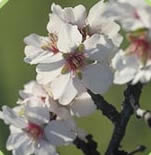

  |
|
As previously mentioned, bees cluster to keep warm, and in the picture above they've found a warm spot in a rather strange place - on top of the veil. The temperature was in the low 50's this day which is close to the minimum temperature at which bees fly, so they seek anything warm in these conditions. They also cluster on your back for the same reason when it's cool and one should be careful about sitting down and leaning back in the seat of the truck, else the bees remind you with their stingers! Not all hives make it and those that don't are removed after "shaking out" the few bees that may have inhabited the boxes and frames. Honey bees can not survive alone - they must live together in a colony - so the stragglers usually buzz around until they join another hive. The equipment, as seen on the truck bed, goes home - to be used again later in the spring to start a new colony by making a split when the hives are stronger. It is desirable to preserve any honey or pollen which may be in the frames of these dead outs, so the equipment is protected by the orange net against robber bees from the many other hives that would otherwise make off with the goodies. At this time of the year, the hives still have food (honey and pollen) stored from the previous season - but there is no abundance of nectar and pollen until the almonds bloom and the bees begin to make almond honey. This honey is not harvested for two reasons: 1. It is dark and has a bitter flavor, and 2. The bees need all the honey they can gather this time of the year to ensure their survival. Aside from that, no honey is ever taken from the two bottom boxes (the deep and the shallow) which belongs to the bees and is exclusively for their maintenance and survival - more on honey production in June. |
 |
The orchards are bare of bloom while we place and work the bees. The main bloom occurs about two weeks after the bees arrive and is a most beautiful sight to see. The orchards turn into a sea of white blossoms as the main bloom comes on. From an economic point of view, the hundred or so dollars per acre the grower spends on bee rental returns thousands of dollars per acre in the almond crop. Bee rental is literally one of the smallest single expenses per acre an almond grower has, yet it produces the highest return. Taken from the growers point of view, renting bees is pretty simple - no bees, no nuts. Learn more about the California Almond crop by following the link on the next page to visit the official web site of The Almond Board of California. |